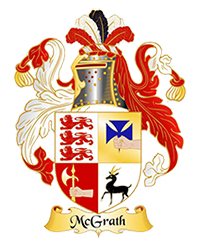
FAMILY CREST
- The 3 lions of the O'Briens, showing we are descendants of the O'Briens
- The Maltese Cross, showing we were dedicated to healing, history and church
- The Battle Axes, showing that we were often involved in battle
- The Antelope, a Mediterranean animal, showing that we came across that Sea to Erin
- The family motto is "SALUS IN FIDE" ..... "SALVATION BY FAITH"
ORIGINS OF THE CLAN
Bardic families, such as the McGraths, claimed that their surname dated from the time of Brian Boru's rule, who became High King of Ireland in 1005 AD.
So if the McGraths are descendants of Ahearne, why did they adopt the surname MacCraith?
In Irish, Magh Rath could mean 'Sons of the ring fort on the plain', Mc Roth could mean 'Sons of the Sun, McGra could mean 'Sons of love', McGrath could mean 'Sons of grace' and Mac Craith might mean 'Sons of the Weaver.'
Liam McGrath in his work 'Our Celtic Christian Heritage' thinks the chosen meaning was 'Sons of grace and prosperity.' From their start, they were bards active in poetry, writing of history and leadership.
A McGrath fought as a captain among the Dal Cassian clans at Clontarf. When he returned to County Clare (Thomond), he was likely asked to write down the account of Brian Boru's death. To write history or poetry is a kind of weaving of a tapestry or record of events. The McGraths have been historians ever since.
Like several other names beginning with McG, MacGrath is often written Magrath (cf. MacGee - Magee; MacGennisn- Magennin, etc). In Irish it is Mac Craith, the earlier form of which is Mac Raith or Mag Raith. Other synonyms still in use, especially in Ulster, are MacGraw, Magraw, MacGra etc. while the same Gaelic surname is found in Scotland as MacCrea, MacRae and Rae.
There are two main septs of MacGrath in Ireland. One was located at Termon MacGrath on the borders of Donegal and Fermanagh, its head being corab of St. Daveog; the other in County Clare where the family supplied ollamhs in poetry or hereditary poets to the O'Briens of Thomond.
MacGraths are still found in Co. Clare, but the present day descendants of the Thomond MacGraths are mostly in Co. Tipperary and Co. Waterford. They were established there in the sixteenth century, for in Geoffrey Keating's boyhood the bardic school at Cahir was under their hereditary guidance; and in Waterford City the ruins of Magrath's Castle are still to be seen.
The Fermanagh MacGraths are now more numerous in the adjacent county of Tyrone. They are found, however, in every county and in all they are estimated to number ten thousand persons, thus constituting one of the hundred commonest names in Ireland, being placed fifty-fifth in the list.
The most remarkable and notorious man of the name was Miler McGrath (1523-1622). Born in Co. Fermanagh he was first a Franciscan friar: later, having become a Protestant, he rose to be Archbishop of Cashel though still holding the Catholic bishopric of Down; in 1604 he held four bishoprics and seventy livings and was twice married.
Another Franciscan, Miler MacGrath, was martyred for the faith in 1650. A brilliant if unstable character was Andrew Mac Grath (d.1790), described by Douglas Hyde as "a very melodious poet but frailest and wildest of the bards". He was of Thomond ancestry and is known as An Mangaire Sugach. John MacRory MacGrath, eleventh century "chief historian of Dail Cais" and John McCraith or MacGrath (son of the Clare poet Rory MacGrath) author (c. 1369) of "Caithreim Toirdhealbhaigh" (The Wars of Turlough) are the most distinguished of that time.
Later, between 1391 and 1463, four of the Clare sept were Bishops of Killaloe. Two at least of the name were men of note in America: the Rev. James MacGrath (1835-1898), who became Provincial of the Oblates in that country; and Andrew Condon Magrath (1813-1893), judge, Governor of Carolina and prominent Confederate in the Civil War, the son of John Magrath who took part in the 1798 Rising and, though captured, escaped to America. Joseph McGrath, veteran of the 1916-21 War of Independence, was well known as a leading racehorse owner and as the organizer of the world-famous Irish Hospitals Sweepstakes.
The text contained in this page is copyright 2000 Liam McGrath
